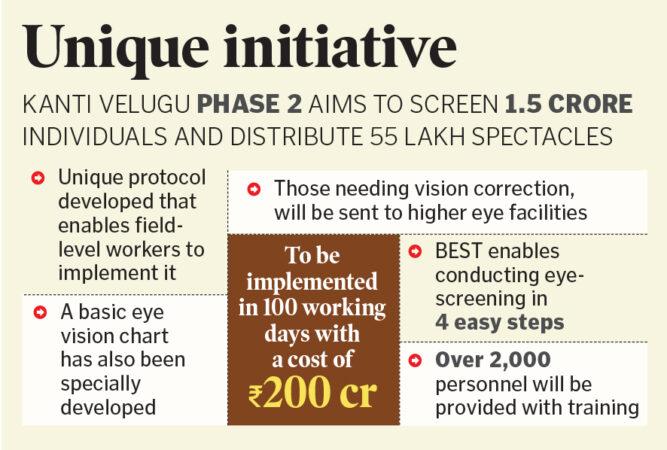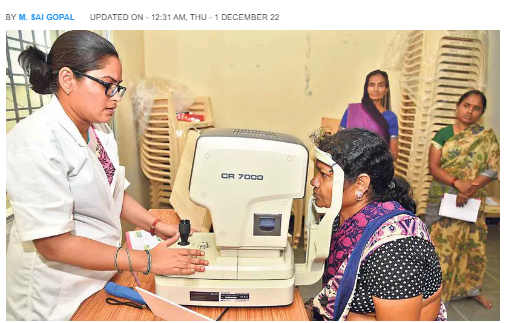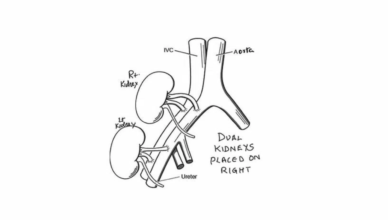Technology and Health: Tech plays key role in Kanti Velugu
Telangana first State in the country to conduct this unique initiative.
Hyderabad: In the coming months, the Telangana government will roll out a unique and massive population-based eye screening programme ‘Kanti Velugu’ that is seldom taken up at that scale by any other State. Organising a mass eye-screening programme with an aim to conduct eye tests for at least 1.5 crore individuals across Telangana does not come easy. As was evident by the success of the first phase of Kanti Velugu in 2018, technology, technical expertise and trained human resource are set to play a huge role in the smooth conduct of the novel initiative.
Implementing this requires critical planning and leveraging a lot of technical know-how, medical infrastructure and trained manpower. From developing exclusive technical protocols to conducting eye screening programmes, procurement of medical infrastructure, training healthcare workers, and customised software for data entry, technology at every level played an important role in the success of Kanti Velugu.
Basic Eye Screening Test (BEST):
Before the first phase of Kanti Velugu, never in the Indian public healthcare system, a mass eye screening programme of such scale was taken up. In fact, Telangana was the first in the country to conduct such a unique initiative before other States including the neighbouring Andhra Pradesh, which borrowed the concept and launched similar initiatives.
Since there was no precedence, the Health Department tapped into the technical prowess of senior eye researchers from L V Prasad Eye Institute (LVPEI). For the first time, to implement the Kanti Velugu scheme, the researchers from LVPEI and Health Department collaborated to innovate Basic Eye Screening Test (BEST) protocol that guided healthcare workers to conduct the initiative.
The LVPEI researchers provided the technical knowledge and close to 200 medical officers, programme managers and paramedical ophthalmic officers were trained. A team of nearly 50 vision experts with technical skills in eye screening from LVPEI were also stationed in districts.
The challenge to implement a mass eye screening programme is to address the inherent shortage of doctors or eye specialists. To address this issue, the BEST protocol was aimed to equip grass-root level health workers to perform basic primary eye screening right at the doorsteps in the community.
In a paper on Telangana Kanti Velugu, published in the prestigious Indian Journal of Ophthalmology in 2020, Dr Srinivas Marmamula of LVPEI says “BEST protocol is low-cost, quick, takes only 2 to 3 minutes, and acts as a triage for referrals to higher levels of care. Specifically, useful for mass community screening programmes, it not only helps to estimate the burden of both distance and near vision loss but also provides information about gross external eye disorders such as pterygium, obvious corneal scar, etc.”
The protocol can be used by ASHA (Accredited Social Health Activist), Auxiliary Nursing Midwifery (ANM) and other grass-root level health workers after two hours of training. The BEST protocol is done with the subject wearing spectacles under good lighting conditions and can be completed in four simple steps.
Methodology
To implement Kanti Velugu, nearly 857 teams were deployed with each team comprising 10 people including 1 Medical Officer, 2 Optometrists, 1 supervisor, 1 ANM, 1 Staff Nurse, 2 ASHA workers and 2 Data Entry Operators. The special teams conducted over 800 eye screening camps across the State for eight months between August 2018 and March 2019.
Before deploying them, the field-level staff were thoroughly trained and given an orientation by eye care experts drawn from research organisations including the LVPEI. The health authorities hired technical personnel like optometrists etc from private facilities and third-party agencies for six months on a contractual basis. The field-level workers used customised software for digital data entry and monitoring. All the patients who were screened, their data was linked to their Aadhaar number, which maintained a lot of transparency









